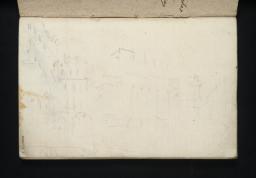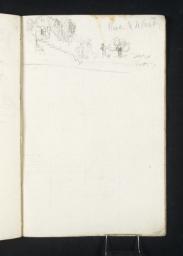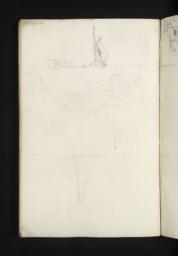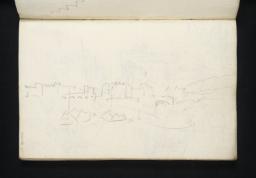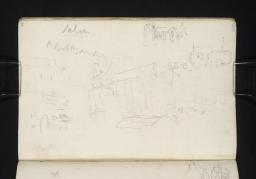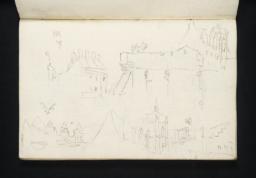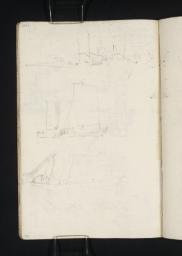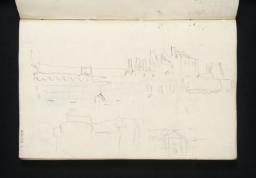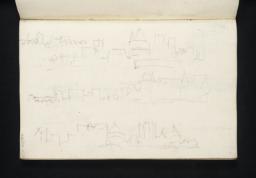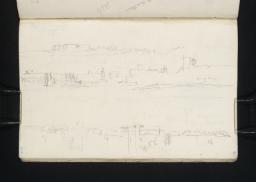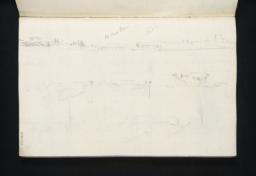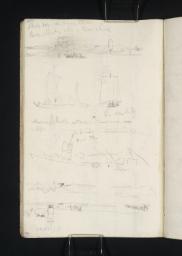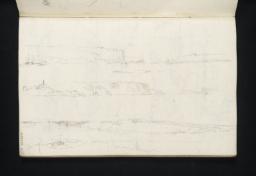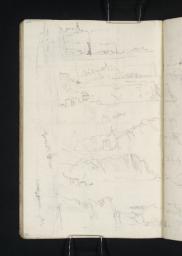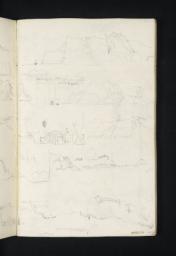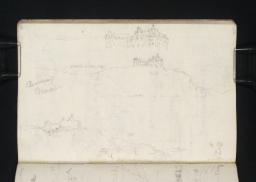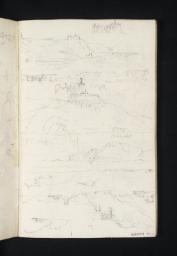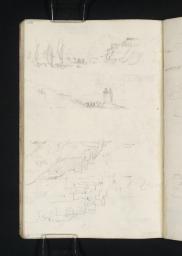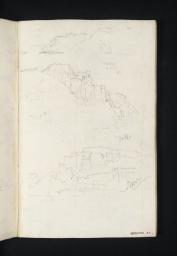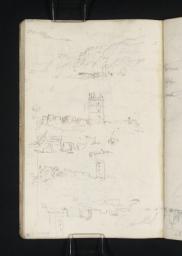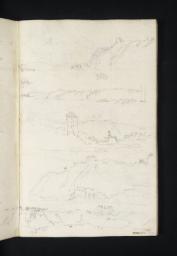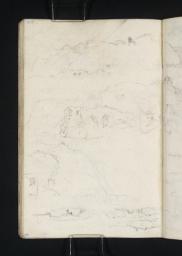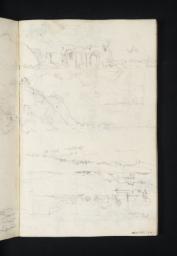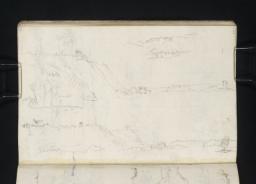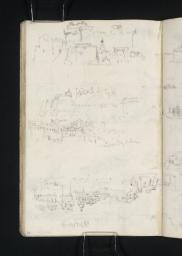Turner Bequest CCXLVIII
Sketchbook bound in marbled paper
48 leaves of white laid paper
Approximate page size 170 x 110 mm
48 leaves of white laid paper
Approximate page size 170 x 110 mm
Accepted by the nation as part of the Turner Bequest 1856
Exhibition history
References
Bound in marbled paper covers, this French-made pocket sketchbook contains pencil drawings of the Loire Valley which Turner visited as part of a tour of northern France in the late summer and early autumn of 1826. The artist appears to have followed an upstream course up the river, making use of this particular volume on the leg of the journey between the cities of Nantes and Saumur, taking in Angers and multiple other historic sites along the way. As laid out in the Introduction to this tour, the great popularity of picturesque and antiquarian French subjects amongst British audiences around this time was very likely the major motivation behind this journey. Turner certainly made extensive record here of the region’s wooded riverside terrain, its distinctive sailed barges, renaissance architecture, and medieval cathedrals and fortifications. Much of this material was subsequently worked up into colour studies on blue paper with a view to supplying designs for printed reproduction. Thus the scenery of the Loire recurs in illustrations for The Keepsake annual (1831) and, more extensively, in Turner’s Annual Tour: Wanderings by the Loire and Seine (1833–5; later reissued as Rivers of France).1
Broadly speaking Turner filled the sketchbook in a methodical fashion, recording views as he encountered them along this eighty-mile stretch of river, working from the front of the volume to the back as currently foliated. Deviations nonetheless occurred from this orderly approach. For example, as Tate curator Ian Warrell has noted, Turner flipped the pages back and forth as he passed by the derelict monastic settlement of Montjean-sur-Loire.2 Having commenced his notations on folio 20 recto (D23188; Turner Bequest CCXLVIII 20), he moved forward to folio 21 recto (D23190; Turner Bequest CCXLVIII 21) and folio 21 verso (D23191; Turner Bequest CCXLVIII 21a) before turning back to folio 20 verso (D23189; Turner Bequest CCXLVIII 20a). Some of the drawings in the sketchbook are loose and cursory in character, such as the view of Nantes on folio 6 verso (D23162; Turner Bequest CCXLVIII 6a), although small but rather densely detailed studies are more frequent, often with several associated views crowded into a page. See, for example, the studies of Angers on folio 31 recto (D23210; Turner Bequest CCXLVIII 31). The most highly worked drawings are reserved for the depiction of notable architectural facades, such as the half-timbered Maison d’Adam at Angers on folio 39 verso (D23227; Turner Bequest CCXLVIII 39a) and the west front of the Cathedral of St-Maurice in the same city on folio 27 recto (D23202; Turner Bequest CCXLVIII 27).
At Nantes, Turner paid particular attention to the medieval cathedral and the remains of its defensive walls, as well as to the newer parts of the city, especially the neo-classical buildings around the grand theatre and the riverside quarter. Studies taken in and around Nantes can be found on folio 1 recto (D23151; Turner Bequest CCXLVIII 1), folios 2 verso to 4 recto (D23154; Turner Bequest CCXLVIII 2a), folio 3 recto (D23155–D23157; Turner Bequest CCXLVIII 3–4), folio 5 recto (D23159; Turner Bequest CCXLVIII 5), folios 6 recto to 8 recto (D23161–D23165; Turner Bequest CCXLVIII 6–8).
Records of the varied landmarks that punctuate the Loire Valley between Nantes and the confluence of the River Maine fill a good portion of this part of the sketchbook, with its mansions, steep bluffs, medieval ruins, and elaborate garden structures. Of particular note for Turner were the river cliffs near Nantes known as the Coteaux de Mauves, the seventeenth-century Château de Clermont, the newly-built gardens buildings of the Folies Siffait descending to the water in narrow terraces, and the remnants of the ancient defences at Champtoceaux and Oudon. More often than not several of these sites are included on a single page at random. These drawings appear on folios 9 recto to 14 verso (D23167–D23178; Turner Bequest CCXLVIII 9–14a). Subsequent pages are filled with studies of the small harbour settlement of Ancenis on folios 15 recto and verso (D23179, D23180; Turner Bequest CCXLVIII 15, 15a) and the abbey town of St-Florent-le-Vieil perched on its hill overlooking the river on folios 16 recto to 17 recto (D23181- D23183; Turner Bequest CCXLVIII 16–17), 18 recto (D23185; Turner Bequest CCXLVIII 18), 19 recto (D23186 ; Turner Bequest CCXLVIII 19). Montjean-sur-Loire appears on folios 20 recto to 21 verso (D23188- D23191; Turner Bequest CCXLVIII 20–21a) and 22 verso (D23193; Turner Bequest CCXLVIII 22a).
To take account of the picturesque city of Angers, with its extensive city walls, gothic ecclesiastical architecture, stone gates, and arched bridges, Turner had to travel a little off the course of the Loire and follow the River Maine a few miles north from the confluence of the two waterways. There are more studies of Angers than any other single location included in the sketchbook. These are included on folios 24 verso to 34 verso (D23197–D23217; Turner Bequest CCXLVIII 24a-34a), 35 verso (D23219; Turner Bequest CCXLVIII 35a), 36 verso (D23221; Turner Bequest CCXLVIII 36a), 37 verso to 38 verso (D23223–D23225; Turner Bequest CCXLVIII 38a), 39 recto to 40 verso (D23226–D23229; Turner Bequest CCXLVIII 39–40a).
There are no sketches recording the thirty-mile journey between Angers and Saumur; an omission which, as Warrell has speculated, may be explained by the possibility of an overnight carriage between the two cities.3 The sights of Saumur, comparable but even more impressive than those at Angers, dominate the latter part of the volume. These drawings can be found on folios 2 recto (D23153; Turner Bequest CCXLVIII 2), 37 recto (D23222; Turner Bequest CCXLVIII 37), 41 verso to 44 recto (D23231–D23236; Turner Bequest CCXLVIII 41a-44), 45 recto (D23238; Turner Bequest CCXLVIII 45), folio 48 verso (D23245; Turner Bequest CCXLVIII 48a); inside back cover (D40689). In the countryside around Saumur, Turner also discovered locations to interest him at the town of Parnay and in the region’s distinctive cave dwellings. The sketches of Parnay are on folios 47 verso to 48 verso (D23243–D23245; Turner Bequest CCXLVIII 47a- 48a). Drawings of the Saumurois cave dwellings are included on folios 44 verso-46 verso (D23237–D23241; Turner Bequest CCXLVIII 44a-46a) and 48 verso (D23245; Turner Bequest CCXLVIII 48a).
Technical Notes
How to cite
John Chu, ‘Nantes, Angers and Saumur Sketchbook 1826’, sketchbook, April 2015, in David Blayney Brown (ed.), J.M.W. Turner: Sketchbooks, Drawings and Watercolours, Tate Research Publication, March 2017, https://www

